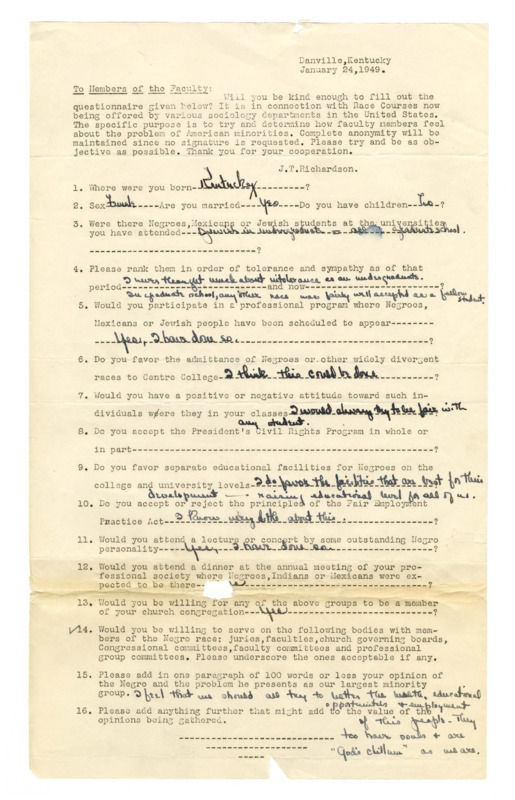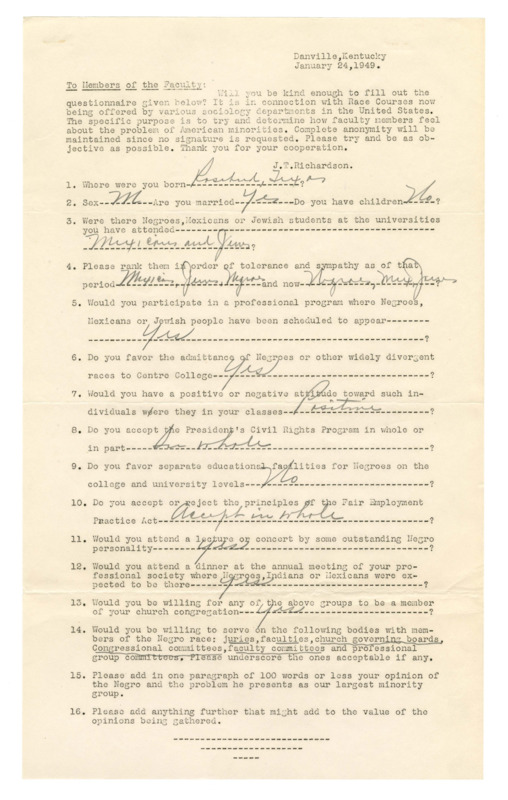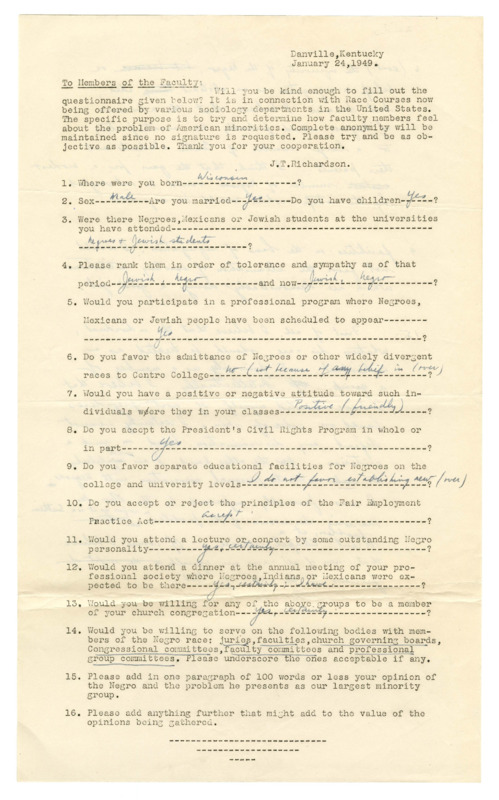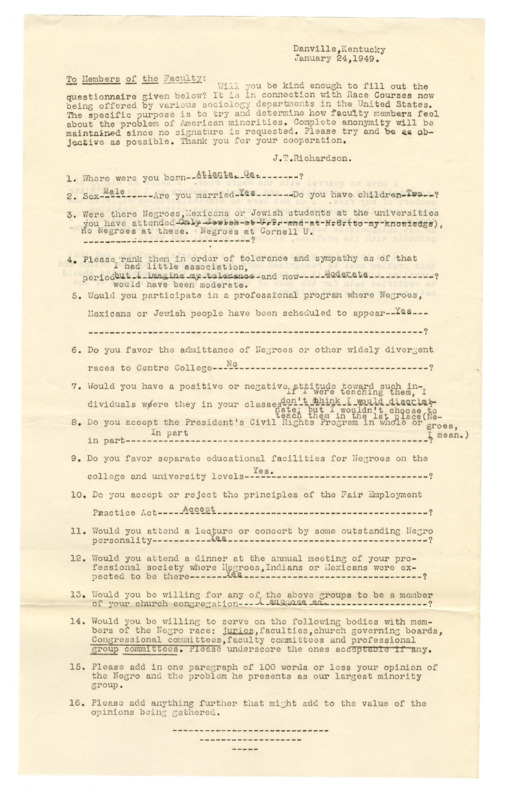Browse the Collection
Browsing 70 items in our archive
Filters: College integration, Boyd, C. LaRue, 1944-, Hillman, Carol Berkley, ca. 1927-, Thomas, June Manning, College student newspapers and periodicals, Brookins, Denise, Singers, Flowers, Willie, Dance, Military education, South Carolina Baptist Convention, Reese, Sarah Clear filters
-
 Rollins College | Text
Rollins College | TextAll De Live Long Day Program, 1934
All De Live Long Day, a program of African American folklore, music, and dance, was the second of two productions by Zora Neale Hurston to be performed on the Rollins campus during the 1930s.Learn more -
 Centre College | Text
Centre College | TextAmerican minorities faculty questionnaire (1)
Anonymous responses to a questionnaire distributed to Centre College faculty January 24, 1949, the stated purpose of which was "to try an determine how faculty members feel about the problem of American minorities."Learn more -
 Centre College | Text
Centre College | TextAmerican minorities faculty questionnaire (10)
Anonymous responses to a questionnaire distributed to Centre College faculty January 24, 1949, the stated purpose of which was "to try an determine how faculty members feel about the problem of American minorities."Learn more -
 Centre College | Text
Centre College | TextAmerican minorities faculty questionnaire (11)
Anonymous responses to a questionnaire distributed to Centre College faculty January 24, 1949, the stated purpose of which was "to try an determine how faculty members feel about the problem of American minorities."Learn more -
 Centre College | Text
Centre College | TextAmerican minorities faculty questionnaire (12)
Anonymous responses to a questionnaire distributed to Centre College faculty January 24, 1949, the stated purpose of which was "to try an determine how faculty members feel about the problem of American minorities."Learn more -
 Centre College | Text
Centre College | TextAmerican minorities faculty questionnaire (2)
Anonymous responses to a questionnaire distributed to Centre College faculty January 24, 1949, the stated purpose of which was "to try an determine how faculty members feel about the problem of American minorities."Learn more -
 Centre College | Text
Centre College | TextAmerican minorities faculty questionnaire (3)
Anonymous responses to a questionnaire distributed to Centre College faculty January 24, 1949, the stated purpose of which was "to try an determine how faculty members feel about the problem of American minorities."Learn more -
 Centre College | Text
Centre College | TextAmerican minorities faculty questionnaire (4)
Anonymous responses to a questionnaire distributed to Centre College faculty January 24, 1949, the stated purpose of which was "to try an determine how faculty members feel about the problem of American minorities."Learn more -
 Centre College | Text
Centre College | TextAmerican minorities faculty questionnaire (5)
Anonymous responses to a questionnaire distributed to Centre College faculty January 24, 1949, the stated purpose of which was "to try an determine how faculty members feel about the problem of American minorities."Learn more -
 Centre College | Text
Centre College | TextAmerican minorities faculty questionnaire (6)
Anonymous responses to a questionnaire distributed to Centre College faculty January 24, 1949, the stated purpose of which was "to try an determine how faculty members feel about the problem of American minorities."Learn more -
 Centre College | Text
Centre College | TextAmerican minorities faculty questionnaire (7)
Anonymous responses to a questionnaire distributed to Centre College faculty January 24, 1949, the stated purpose of which was "to try an determine how faculty members feel about the problem of American minorities."Learn more -
 Centre College | Text
Centre College | TextAmerican minorities faculty questionnaire (8)
Anonymous responses to a questionnaire distributed to Centre College faculty January 24, 1949, the stated purpose of which was "to try an determine how faculty members feel about the problem of American minorities."Learn more -
 Centre College | Text
Centre College | TextAmerican minorities faculty questionnaire (9)
Anonymous responses to a questionnaire distributed to Centre College faculty January 24, 1949, the stated purpose of which was "to try an determine how faculty members feel about the problem of American minorities."Learn more -
 Rollins College | Text
Rollins College | TextAnnual Report of the Race Relations Committee, 1946
Carol Berkley, a member of the Race Relations Committee, describes the work of the group from January to March 1946, including holding Race Relations Sunday, volunteering at the Hungerford School, and working with local African American high schools. The description gives insight into the focus of the group from its start and how they are attempting to improve race relations locally.Learn more -
 Furman University | Text
Furman University | TextBaptist Board Challenges Trustee Integration Policy
An article appearing in Furman's student newspaper, The Paladin, dated October 26, 1963, detailing a challenge, made by the General Board of the South Carolina Baptist Convention, to the Furman trustee's resolution authorizing Furman to admit all qualified applicants regardless of race.Learn more -
 Rollins College | Image
Rollins College | ImageBlack Student Union, 1974-1975
Thirteen members of the Black Student Union gather for their yearbook photo. They are seated on the steps of Bush Science Center. (First row, left to right): Douglas Pollard, Denise Brookins, Blondie Jones, Priscilla Lyons, Roxwell Robinson. (Second row, left to right): Vic Crumity, Errol Cunningham, Willie Flowers, Dick Twine, Roslyn Lawson, Luther Graham, Kimberly Broxton, Sharon Israel.Learn more -
 Rollins College | Image
Rollins College | ImageBlack Student Union, 1975-1976
Fourteen Black Student Union members pose for their student organization’s yearbook photograph. (First row, left to right): Blondie Jones, Priscilla Lyons, Debbie Mitchell, Kim Broxton, Denise Brookins, Rosalyn Lawson. (Second row, left to right): Aaron Spencer, Roxwell Robinson, Tim Graddy, Dirk Twine, Willie Hicks, Victor Crumity, Doug Pollard, Luther Graham.Learn more -
 Rollins College | Image
Rollins College | ImageBlack Student Union, 1976-1977
(First row, left to right): Sharon Israel, Kim Broxton, Debbie Mitchell, Roslyn Lawson, Blondie Jones, Denise Brookins, Gloria Allen. (Second row, left to right): Victor Crawford, Clyde Clark, Thomas Francis, Gigi Morgan, Luther Graham, Rodney Akins, Kirk Twine. Fourteen Black Student Union members gather around a sofa for their yearbook picture. This is the fourth such yearbook photograph of Black Student Union members gathered for their student organization picture.Learn more -
 Furman University | Text
Furman University | TextBoard To Recommend 'Hands-Off' Policy to Baptist Convention
An article appearing in Furman's student newspaper, The Paladin, dated October 23, 1964. The author writes about the General Board of the South Carolina Baptist Convention's recommendation that the convention abopt a hands-off policy towards desegregation. Admission policies would be left to the trustees of it's church supported colleges.Learn more -
 Furman University | Text
Furman University | TextCharter Change Ordered: Students Found Dazed
An article appearing in Furman's student newspaper, The Paladin, dated November 11, 1961, describing, in detail, a meeting of the South Carolina Baptist Convention where the members voted to amend the charter of Furman University to prohibit Greek letter social fraternities from the campus of Furman, as well as all of the Convention's educational institutions.Learn more -
 Furman University | Text
Furman University | TextFight Goes On, But Candidly, Is Finished
Column, entitled 'Candidly,' written by student, Chuck Graham '62, appearing in Furman's student newspaper, The Paladin, dated May 19, 1962. Graham is ending his column as he is graduating soon, but writes that the struggle for power over Furman, which 'straddles the two worlds of a narrow, denominational school and a leading educational institution,' will continue to be fought.Learn more -
 Furman University | Text
Furman University | TextFinal Decision Is Trustees'
An editorial appearing in Furman's student newspaper, The Paladin, dated November 16, 1963. The author is calling for the Furman Board of Trustees to be strong and not bend to the will of the South Carolina Baptist Convention.Learn more -
 Furman University | Image
Furman University | ImageFurman Chapter of the Southern Student Organizing Committee
Photograph of the Furman Chapter of the Southern Student Organizing Committee, an organization of students committed to peace, racial equity, and participatory democracy. From the 1968 Furman yearbook: 'SSOC is convinced that society is in need of radical reform on every level, including the university level. It is our purpose to work for these reforms, both through education and direct action. Ready to organize are the members of the Southern Student Organizing Committee.Learn more -
 Furman University | Image
Furman University | ImageFurman Concert Choir
Joseph Vaughn '68 performing in the Furman Concert Choir. Vaughn became the university's first African American student on Jan. 29, 1965.Learn more -
 Furman University | Image
Furman University | ImageFurman Concert Choir
The 1969-1970 Furman University Concert Choir. A member of the choir, Sarah Reese '71, can be seen at the far right in photo, third row. Reese enrolled at Furman in 1967 as one of the university's first African American women. Sarah Reese would later become a world-famous opera singer.Learn more
